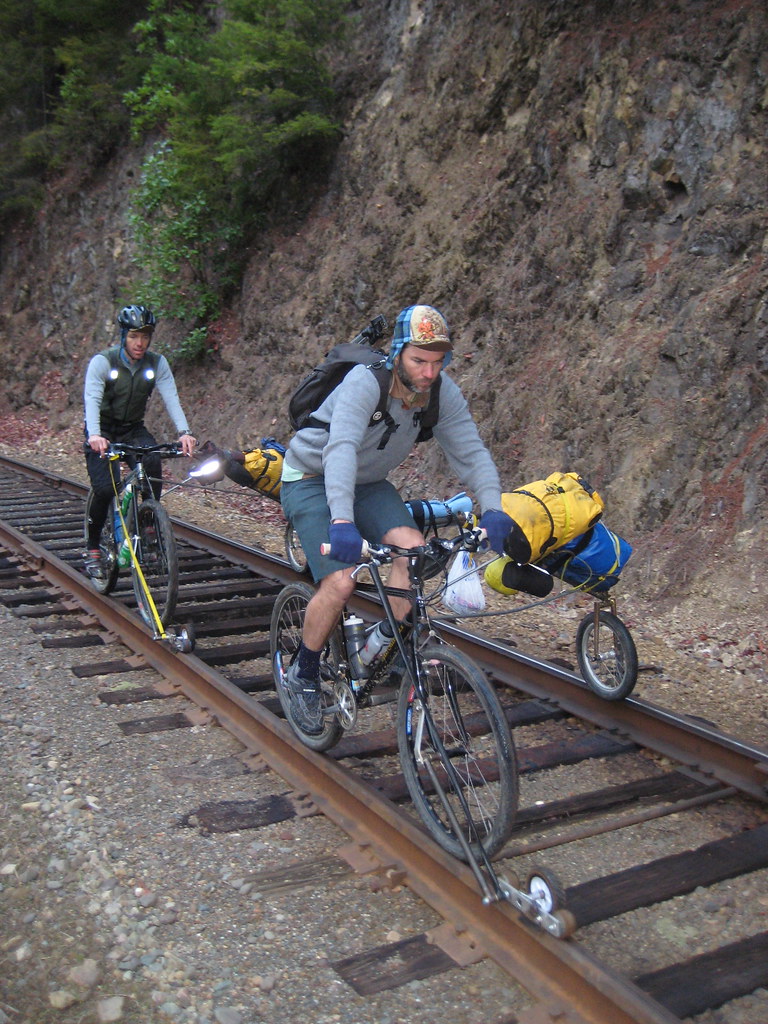Some of you have benefited from the work of the Rails-To-Trails Conservancy. As their name indicates, they have worked to convert disused and abandoned railroad right-of-ways to paths for cycling, hiking and other non-motorized means of transportation.
Like canal towpaths, railbeds make for all-but-ideal bike paths. They are usually flat; if there is an incline, the grade is gradual and even. Plus, towpaths and railbeds are usually well-conceived and well-built, at least in part because the best engineers of their time worked on them; the Pennsylvania, New York Central, Union Pacific, and Baltimore and Ohio railroads attracted, and paid for, scientific and technical acumen as the major automobile manufacturers and aerospace companies would in later years.
Also, many old railroad viaducts, bridges and overpasses have endured because, ironically, in the early days of railroad engineering, nobody really knew which materials and methods were most suitable. So, the early railroads--particularly the Baltimore and Ohio, erred on the side of caution and used what they thought were the strongest materials--as often as not, granite and iron.
What all of this means, of course, is that to make a good trail, sometimes it's not necessary to do much more than remove the tracks.
Or maybe not even that.
Believe it or not, in 1891, one Frank Brady of Chicago, Illinois got a patent for a bicycle much like that one.


Apparently, he wasn't the only one to patent a railway bicycle. This one sprung from the mind of Allegheny, Pennsylvania native Henry Mann, and was patented a year after Brady's contraption:

Given that the 1890s were a Golden Age for both railroads and bicycles, it's no surprise that Brady and Mann weren't the only ones who, in that era, thought that "pedal to the metal" meant a velocipede on rails:

Note that in all of these patents, the vehicle in question is referred to as a "velocipede". That was the common term for any pedaled vehicle; the Teetor vehicle in the 1898 patent has four wheels.

Also note that the Teetor vehicle is referred to as an "inspection car". Can you imagine how the world would be different if our cars were like that instead of the ones we have now? Would our Interstate system consist of rails of steel rather than ribbons of asphalt?
Apparently, as the Bike Boom of the 1890s and early 1900s ended, so did attempts to make bikes that rode on rails.
Like canal towpaths, railbeds make for all-but-ideal bike paths. They are usually flat; if there is an incline, the grade is gradual and even. Plus, towpaths and railbeds are usually well-conceived and well-built, at least in part because the best engineers of their time worked on them; the Pennsylvania, New York Central, Union Pacific, and Baltimore and Ohio railroads attracted, and paid for, scientific and technical acumen as the major automobile manufacturers and aerospace companies would in later years.
Also, many old railroad viaducts, bridges and overpasses have endured because, ironically, in the early days of railroad engineering, nobody really knew which materials and methods were most suitable. So, the early railroads--particularly the Baltimore and Ohio, erred on the side of caution and used what they thought were the strongest materials--as often as not, granite and iron.
What all of this means, of course, is that to make a good trail, sometimes it's not necessary to do much more than remove the tracks.
Or maybe not even that.
Believe it or not, in 1891, one Frank Brady of Chicago, Illinois got a patent for a bicycle much like that one.
Apparently, he wasn't the only one to patent a railway bicycle. This one sprung from the mind of Allegheny, Pennsylvania native Henry Mann, and was patented a year after Brady's contraption:
Given that the 1890s were a Golden Age for both railroads and bicycles, it's no surprise that Brady and Mann weren't the only ones who, in that era, thought that "pedal to the metal" meant a velocipede on rails:
Note that in all of these patents, the vehicle in question is referred to as a "velocipede". That was the common term for any pedaled vehicle; the Teetor vehicle in the 1898 patent has four wheels.
Also note that the Teetor vehicle is referred to as an "inspection car". Can you imagine how the world would be different if our cars were like that instead of the ones we have now? Would our Interstate system consist of rails of steel rather than ribbons of asphalt?
Apparently, as the Bike Boom of the 1890s and early 1900s ended, so did attempts to make bikes that rode on rails.
